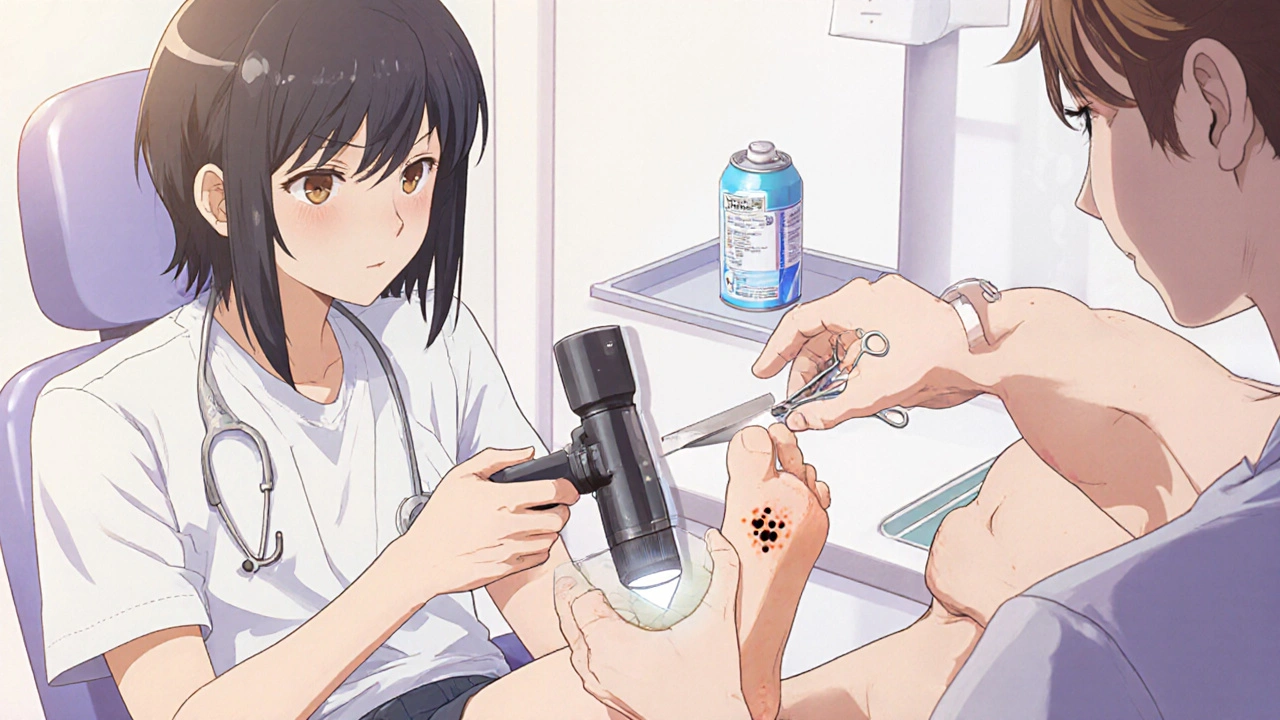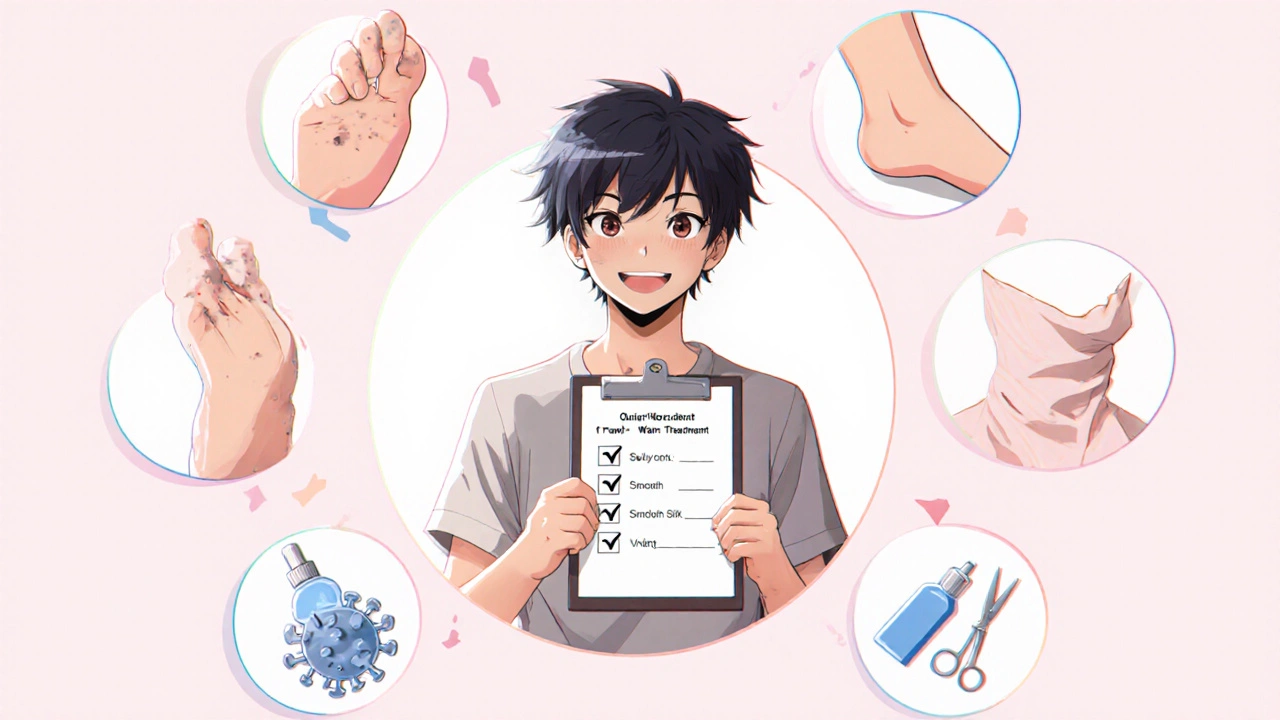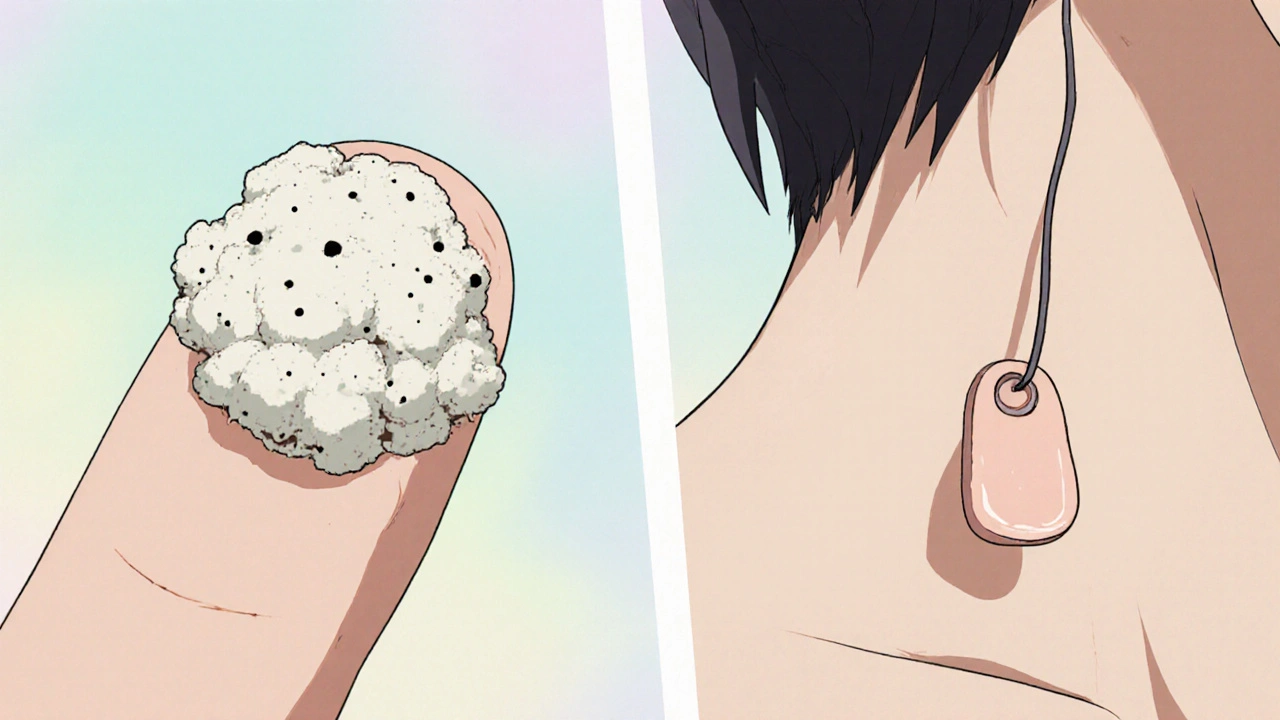Warts vs Skin Tags Identifier
Quick Diagnostic Tool
Answer these questions to determine if your skin growth is more likely a wart or skin tag.
Where is the growth located?
What's the texture like?
Does it have any black dots?
Does it cause pain or itching?
Ever stared at a bump on your skin and wondered, “Is this a wart or a skin tag?” You’re not alone. Misidentifying these harmless growths can lead to unnecessary worry or ineffective home remedies. This guide breaks down the visual clues, causes, and treatment options so you can tell the difference the first time you spot one.
What Are Warts?
Warts are small, rough growths caused by an infection with the human papillomavirus (HPV). They commonly appear on the hands, feet, and face, and can vary in size from a pinhead to a pea‑sized lump. Because HPV is a virus that targets the top layers of the skin, warts feel firm and may have a cauliflower‑like surface.
What Are Skin Tags?
Skin tags are soft, flesh‑colored flaps of skin that hang from a narrow stalk. They’re medically known as acrochordons and often show up in folds like the neck, armpits, groin, and under the breasts. Unlike warts, skin tags are not caused by a virus; they’re usually the result of friction and genetic factors.
Visual Differences at a Glance
Seeing a bump is one thing; recognizing its type is another. Below is a quick side‑by‑side comparison.
| Feature | Warts | Skin Tags |
|---|---|---|
| Cause | Human papillomavirus infection | Friction, genetics, obesity |
| Typical locations | Hands, feet, face | Neck, armpits, groin, under breasts |
| Texture | Rough, raised, sometimes with black dots (thrombosed capillaries) | Soft, smooth, hangs like a tiny tag |
| Color | Skin‑tone to brown; may darken with irritation | Same color as surrounding skin |
| Pain or tenderness | Usually painless unless cracked or irritated | Generally painless, rarely itchy |

Underlying Causes and Risk Factors
Understanding why each growth appears helps you predict where else they might show up.
- Human papillomavirus (HPV) is the direct cause of warts. Over 100 HPV types exist, but types 1, 2, and 4 are most linked to common warts. The virus thrives in warm, moist environments, which is why pool decks and locker rooms are hotspots.
- Skin tags arise from repeated skin‑to‑skin friction, especially in areas where skin folds. Obesity and hormonal changes (e.g., pregnancy) increase the likelihood.
- Both conditions are more common in teenagers and young adults, though skin tags often increase with age.
How Professionals Diagnose the Difference
While a quick visual check can usually separate the two, dermatologists use a few tools for certainty.
- Dermoscopy-a handheld magnifier with light-reveals the tiny black dots characteristic of warts (thrombosed capillaries) and the smooth vascular pattern of skin tags.
- If uncertainty remains, a biopsy can be performed. A tiny tissue sample is examined under a microscope to confirm the presence of viral changes in the skin cells.
- Self‑assessment works for most people: warts feel firmer and have a rough surface; skin tags feel soft and hang freely.
Treatment Options: What Works Best for Each?
Because the causes differ, so do the treatments. Below are the most common, evidence‑backed methods.
Wart Treatments
- Salicylic acid liquid or patches slowly dissolve the thickened skin over weeks. Regular filing after each application speeds the process.
- Cryotherapy-freezing the wart with liquid nitrogen-causes the infected cells to die. Most dermatology clinics perform one‑to‑three sessions.
- For stubborn plantar warts, a minor surgical excision or laser therapy may be recommended.
Skin Tag Treatments
- Simple snipping with sterile scissors or a scalpel, often performed in a doctor’s office, removes the tag in seconds.
- Cauterization-using a small electric current-seals the base and minimizes bleeding.
- Over‑the‑counter skin‑tag removal kits use a mild acid to dry out the stalk. These are safe for small tags but should be avoided on larger growths.
Both warts and skin tags are benign, meaning they aren’t cancerous. However, removing them yourself without proper technique can lead to infection or scarring.

When to See a Dermatologist
Most growths are harmless, but schedule a professional appointment if you notice any of the following:
- Rapid growth or change in color.
- Pain, bleeding, or a foul smell.
- Multiple warts spreading across an area, especially on the feet.
- Uncertainty-if you can’t confidently tell whether it’s a wart or a skin tag.
A board‑certified Dermatologist can confirm the diagnosis and suggest the safest removal method.
Quick Checklist: Spot the Difference
- Location: Warts on hands/feet, skin tags in skin folds.
- Texture: Rough and raised warts; soft, dangling skin tags.
- Cause: Virus (HPV) vs. friction/genetics.
- Treatment: Acid/cryotherapy for warts; snip or cauterize for skin tags.
- When to seek help: Pain, rapid change, or doubt.
Frequently Asked Questions
Can warts turn into skin tags?
No. Warts and skin tags have completely different causes. A wart is a viral infection, while a skin tag is a harmless overgrowth caused by friction or genetics.
Are skin tags a sign of health problems?
Mostly they’re cosmetic. However, a sudden increase in skin tags can sometimes indicate insulin resistance or hormonal shifts, so discuss any concerns with a doctor.
Is it safe to remove a wart at home with OTC salicylic acid?
Yes, for small, uncomplicated warts. Follow the product instructions, keep the area clean, and stop if you experience excessive pain or irritation.
How long does it take for a skin tag to grow?
Skin tags can develop over weeks to months. They often start as a small papule and gradually elongate into a stalk.
Can warts spread to other parts of the body?
Yes. Because HPV is contagious, touching a wart and then another skin area can transfer the virus. Keep warts covered and avoid picking at them.
Now you’ve got a clear roadmap to differentiate warts vs skin tags and choose the right next step. Whether you opt for an over‑the‑counter remedy or a quick visit to a dermatologist, you’ll know exactly what you’re dealing with.


Reading through the guide makes you realize how easy it is to confuse a wart with a skin tag, especially when they pop up in unexpected places. The main thing I take away is to look at texture first-warts feel rough and firm, while tags are soft and hang like little flaps. Location is another clue; if you find it on your hands or feet, odds are it’s a wart, whereas tags love skin folds like the neck or underarms. It’s also helpful to remember that warts are virus‑driven, so they can spread if you pick at them, while tags are just a harmless overgrowth. In practice, a quick self‑check using these visual cues can save a trip to the dermatologist, but don’t hesitate to get a professional opinion if anything feels off.